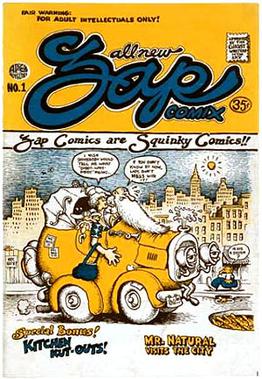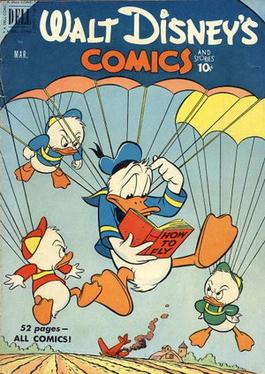
2000 AD is a weekly British science fiction-oriented comic magazine. As a comics anthology it serialises stories in each issue and was first published by IPC Magazines in 1977, the first issue dated 26 February. Since 2000 it has been published by Rebellion Developments.

Uncle Scrooge is a Disney comic book series starring Scrooge McDuck, his nephew Donald Duck, and grandnephews Huey, Dewey, and Louie, and revolving around their adventures in Duckburg and around the world. It was first published in Four Color Comics #386, as a spin-off of the popular Donald Duck series and is still presently ongoing. It has been produced under the aegis of several different publishers, including Western Publishing, Gladstone Publishing, Disney Comics, Gemstone Publishing, Boom! Studios, and IDW Publishing, and has undergone several hiatuses of varying length. Despite this, it has maintained the same numbering scheme throughout its six decade history, with only IDW adding a secondary numbering that started at #1.

Underground comix are small press or self-published comic books that are often socially relevant or satirical in nature. They differ from mainstream comics in depicting content forbidden to mainstream publications by the Comics Code Authority, including explicit drug use, sexuality, and violence. They were most popular in the United States in the late 1960s and 1970s, and in the United Kingdom in the 1970s.
Disney comics are comic books and comic strips featuring characters created by the Walt Disney Company, including Mickey Mouse, Donald Duck and Scrooge McDuck.

Walt Disney's Comics and Stories, sometimes abbreviated WDC&S, is an American anthology comic book series featuring characters from The Walt Disney Company's films and shorts, including Donald Duck, Scrooge McDuck, Mickey Mouse, Chip 'n Dale, Li'l Bad Wolf, Scamp, Bucky Bug, Grandma Duck, Brer Rabbit, Winnie the Pooh, and others. With more than 700 issues, Walt Disney's Comics & Stories is the longest-running Disney comic book in the United States, making it the flagship title, and is one of the best-selling comic books of all time.
Doctor Who spin-offs refers to material created outside of, but related to, the long-running British science fiction television series Doctor Who.
Luciano Bottaro was an Italian comic book artist.

Marvel UK was an imprint of Marvel Comics formed in 1972 to reprint US-produced stories for the British weekly comic market. Marvel UK later produced original material by British creators such as Alan Moore, John Wagner, Dave Gibbons, Steve Dillon, and Grant Morrison.
Notable events of 1952 in comics.

Crestwood Publications, also known as Feature Publications, was a magazine publisher that also published comic books from the 1940s through the 1960s. Its title Prize Comics contained what is considered the first ongoing horror comic-book feature, Dick Briefer's "Frankenstein". Crestwood is best known for its Prize Group imprint, published in the late 1940s to mid-1950s through packagers Joe Simon and Jack Kirby, who created such historically prominent titles as the horror comic Black Magic, the creator-owned superhero satire Fighting American, and the first romance comic title, Young Romance.

Mickey Mouse is a Disney comic book series that has a long-running history, first appearing in 1943 as part of the Four Color one-shot series. It received its own numbering system with issue #28, and after many iterations with various publishers, ended with #330 from IDW Publishing.

Western comics is a comics genre usually depicting the American Old West frontier and typically set during the late nineteenth century. The term is generally associated with an American comic books genre published from the late 1940s through the 1950s. Western comics of the period typically featured dramatic scripts about cowboys, gunfighters, lawmen, bounty hunters, outlaws, and Native Americans. Accompanying artwork depicted a rural America populated with such iconic images as guns, cowboy hats, vests, horses, saloons, ranches, and deserts, contemporaneous with the setting.

Tiramolla is an Italian comic book character created in 1952 by Roberto Renzi and Giorgio Rebuffi.

Geppo is the title character of an Italian comic series created by Giovan Battista Carpi.

Baldo is the title character of an Italian comic series created by Luciano Bottaro. He is a Canadian Mountie.

Cucciolo is the title character of an Italian long-lasting comic book series.

Pugacioff is the title character of an Italian comic series created by Giorgio Rebuffi.

Didier Conrad is a French comics artist and writer. Since 2012, he has been the artist of the popular Asterix series.

Angelo Carlo Chendi was an Italian cartoonist.














